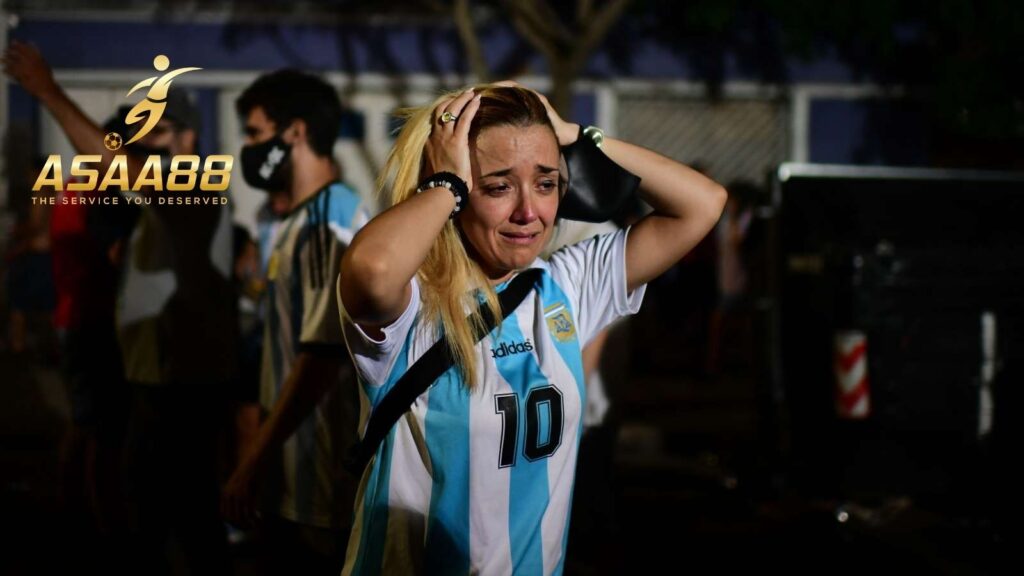The late World Cup hero was the most Argentine of icons to his adoring fans, as much because of his failings as his unique talents on the pitch.

“Diego hasn’t died, Diego hasn’t died, Diego lives with the people and that’s just the way it f*cking is.”
Buenos Aires’ imposing Obelisco, the monument built in 1936 to commemorate the city’s 400th anniversary, has long served as the gathering point for Argentines to celebrate.
It was there, on June 29, 1986, that hundreds of thousands of ecstatic fans flocked to mark the nation’s World Cup final victory over West Germany, masterminded by one Diego Armando Maradona.
It was fitting, then, that the Obelisco was one of the places chosen to commemorate the life of a man who touched Argentine hearts perhaps more than any other individual in recent memory.
Despite the difficulties that coronavirus and lockdown measures continue to impose on public events, thousands knew instinctively once the news broke that Diego Maradona had passed away aged 60 on Wednesday that they had to make their way to the centre of Buenos Aires.
Others paid tribute at the steps of the Bombonera, Boca Juniors’ iconic home where Maradona had once starred and now has become a shrine to ‘God’, (the club’s Libertadores match against Internacional was postponed in respect to the late legend), while others made their way to the place where it all began, Argentinos Juniors’ stadium in La Paternal which saw Diego take his first steps in professional football and which, in 2004, took the name of its favourite son.
Many more in the coming days will file past the late legend as he lies in state at the Casa Rosada, the Argentine seat of government, from where
President Alberto Fernandez – an Argentinos Juniors fan himself – delivered a poignant tribute to his idol shortly after the tragic news broke, and decreed 72 hours of national mourning.

Wherever these impromptu remembrance ceremonies take place, though, one golden rule seemed to hold: this is a time for sadness, but also for celebration, as a nation comes together to remember its rebellious, wayward yet fiercely proud and patriotic standard-bearer for the great footballer and larger than life figure that he was.
There were plenty of tears at the Obelisco as the sun went down on a muggy spring afternoon in the Argentine capital. But there were also drums, chants, dancing and flares, while enterprising salesmen did the round selling cans of beer to those not forewarned enough to have prepared their own cooler.
“Ole, ole ole ole, Diego, Diego!” rang out among the masses, many of whom were far too young to have seen El Pibe de Oro in his prime but who have grown up imbibing the stories of the diminutive hero as he took on the world.
Not since former president Nestor Kirchner, a close friend of Diego, passed away in 2010 has the country lost such an immense public figure; and as with the late politician, the cry went up that Maradona had not died, but lived on still in the heart of the people.
Maradona’s old adversaries England and Brazil were also remembered among the chants, which grew in volume as the evening progressed. At one point, a nearby electronic billboard replayed his iconic ‘Goal of the Century’ in the 1986 World Cup quarter-final; the crowd jeered every flailing Englishman the little genius left in his wake before coming together as one to cry “Goooooool” as the ball finally nestled in the back of the net.
Boca fan Hernan, 38, was in the middle of a regular Wednesday when, through Twitter, he learned of the rumours that were shortly confirmed.
“I dropped what I was doing and came straight down here to the Obelisco,” he explained.
“I saw him play in 1995, in Boca, I saw him too when he retired in River’s stadium, I also went to his farewell match and the last time I saw him in a stadium was at Boca, on March 10 (when Diego’s Gimnasia visited the Xeneize).
“It’s sad news, really, I didn’t expect it, I thought he was getting better, you know. Diego could always dribble past everyone, we thought this would pass and, it’s very sad. Awful.
“It’s a shame but, well, he’s going to live forever. Diego is always going to be with us.”
Argentine football is famed for its tribal instincts. On Wednesday, though, a mournful ceasefire reigned.
Shirts and banners belonging to Maradona’s beloved Xeneize and the Argentina national team were out on force; but so too were those of River, Racing Club, Huracan, current club Gimnasia, Talleres and a kaleidoscope of other clashing colours, including the yellow and black of Uruguayan giants Penarol.
“I had no hesitation, I put on my shirt,” 40-year-old River fan Fernando told, decked in the colours of the team Maradona had so often delighted in tormenting over the years.
“I cried for two hours at home when I heard around midday and I came here, I had no choice. I thought about [the shirt] but I thought, today we are here to pay our respects to football, no matter the shirt. I am here to support God. It’s really a moment of immense sadness.
“I see shirts from many places, banners too, and this is what Maradona was, I think that if you go anywhere in the world and say, Maradona, that’s it, it’s Argentina. Maradona is football and he is Argentina.”
Fellow River supporter Julio, who was working nearby in Buenos Aires’ downtown area when he heard the news, expressed similar sentiments.
“I was 20 when the 1986 World Cup was held, with all my family, and I cannot forget that moment he gave us, that moment of happiness,” the 54-year-old said.
“We had come out of a war in 1982 [the Falklands/Malvinas conflict with the United Kingdom], we needed some joy. Diego, like a hero with his team gave us that happiness, and on top of it all playing against the English, it really was unforgettable.
“Diego is our identity, today we are known in the world, you would say Diego Maradona and everybody knew you were Argentine… it is a tough moment because the soul, the soul is broken, it’s our soul, the Argentine soul, and it’s a shame that he had to go like this.”
In the wake of Wednesday’s passing many media outlets, particularly in the English-speaking world, opted to focus on what they dubbed the flawed genius of Maradona, suggesting that his wizardly ability on the ball was somehow tarnished by his chequered personal life and, even more inexplicably, his struggles with addiction, a disease that dogged him throughout his adult years.
Such an interpretation of Diego’s legacy would find short shrift around Buenos Aires. He was not perfect, not even to his most avid followers, and caused himself and those closest to him great pain with many of the decisions he made, particularly after leaving the sport in the 1990s.
It is Diego’s ‘flaws’, however, that made him appear human in a way many elite sportsman, particularly in the image-obsessed modern world, do not; and in turn his humanity that, paradoxically, elevated him to deity status.
His beginnings; his joys; his setbacks and demons: all can be understood intimately in a nation accustomed to crisis and recovery, the hope that tomorrow will be a better day.
“Diego is Argentine, he is ours, and that is what’s missing from Messi, Argentine blood,” Julio continued. “He was born below, he took in all of the essence from the Argentine potrero (informal street football).
“You can’t compare Maradona with Messi, you cannot, but he is the best we have today and we have to take care of him like they didn’t with Maradona. Please!”


